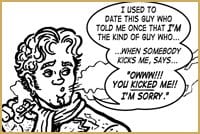
MEET JEFF: A snapshot of Ken Boesem's main character, the Charlie Brownesque Village dweller named Jeff. Credit: Ken Boesem
First there was Coronation Street. Then along came Tales of the City. And now there’s The Village.
This issue marks the one-year anniversary of Ken Boesem’s Xtra West comic strip The Village, a slice-of-life comic narrative that follows a group of Davie Villagers as they struggle with love, dating, work, money and friends.
Boesem, a Vancouver artist and writer who has been honing his skills since he was able to pick up a pencil, has been waiting for the strip to come to fruition since his student days at Kelowna’s Okanagan University College.
Inspired by serial narratives like Coronation Street while studying for his degree, he also worked for years on the comic strip that would eventually be resurrected to become The Village.
“The Village is sort of a complicated thing for me to talk about, because it has a longer internal history to me than it does in the world,” Boesem says. “But it’s been repositioned in the Davie Village and in the course of working on it, it’s become this really different animal.”
Growing up in Quesnel, Boesem had always been fascinated by communities that share stories. With a dad that often worked away from home and a brother who was five years older and off with friends, Boesem usually found himself at home with his mother and grandmother, watching soap operas, and listening to family stories and friendly neighbourly gossip.
With serialized fiction, Boesem says, you carry around the characters’ histories with you and that helps to fuel a culture of gossip. This culture of gossip is the frame for Boesem’s work, the kind of work that focuses on characters that are well developed and relatable rather than those that are unrealistic and sensationalized.
“I’ve done some studies about why soap operas are popular in societies where a culture of gossip exists,” Boesem explains. “Because soap operas are all about gossip and what’s going on in the community, and because the viewing of them requires you to talk to other people about what’s going on and catch up on a storyline you’ve missed, it ties into a community of gossip that already exists. I kind of think that’s true of the gay community, which is part of the reason why I think there’s a gay audience for soap operas.
“I joked to a friend the other night that the gay male community is sort of like an American soap opera: all these people that have lived in the same town for years and years, and they’ve all dated each other and they all go to parties and pretend to be nice to each other,” he laughs.
In writing The Village, Boesem aims to create characters that people will care about and want to get to know, without the soap opera flash of overdramatic evil twins and demonic possessions. And since the strip has a queer bent to it, he likes the idea of chronicling the social realisms of the local community.
“It’s really an interesting mix of people here and especially in terms of the gay angle, because gay cuts across all social barriers,” Boesem says. “You can be a poor working-class gay guy or you can be a gay doctor who lives in a penthouse. But you may go to the same bar. It’s a locus for bringing together people who aren’t normally necessarily brought together.”
Readers are brought into the world of The Village through the eyes of Jeff, a Charlie Brownesque Village dweller who anchors the rest of the characters. And it’s Jeff that’s probably the most like Boesem himself.
“I have a friend who teases me when we talk about the strip,” Boesem says. “He’ll be like, ‘And Jeff, who you think is not you.’ And I’m like, ‘He’s not me. They’re all me. He may be closest to me, but he’s not me.'”
Though Jeff is Boesem’s favourite character, he often draws inspiration from a variety of sources, including his original university comic strip incarnation and from the people he’s met, for both the visual and personality side of his characters.
“Characters are a combination of things,” he says. “They sort of become composites of people you know or people you’ve met. Or certain types. Like Jeff and his friends Cam and Mo sort of mirror a friendship I had for a few years. But then the characters aren’t actually us so it’s not quite the same.”
It takes Boesem about two days on average to write an episode of The Village, from developing the conversations that the characters are having to setting a locale and doing the artwork. He tries to add in as many local hubs as possible, typically coffee shops. Scenes are written out on index cards, where they can be switched around throughout the creative process. Though the strip is very visual, it’s actually the writing that Boesem finds most exciting.
“Doing the writing is actually my favourite part,” he says. “I mean, I really like doing the artwork too, but when it gets to the point of doing the artwork, it’s all kind of figured out. It’s sort of like the designing of the building is over and the building of the building has to start.”
It’s important to Boesem to create characters that are developed and relatable, as well as have each strip appeal to both new and loyal readers.
“I want people who’ve never read it before who happen to pick up the paper and read it to get something out of it,” he says. “For me, that means there has to be something in the scene that’s entertaining or funny. But then in the larger sense, I want people who read it regularly to have a reason to come back and want to know what’s going to happen.”
As for what’s going to happen next in the world of The Village, Boesem has an overarching plan for the next couple of years, but won’t reveal too much when it comes to the details. All he’ll say is that Jeff might actually find love in the coming months, and Sarbjit will plunge into deeper debt and trouble with her student loans.
Readers can also look forward to a website about The Village in the new year that will have information such as character biographies and explanations about how all the characters are related.
Boesem is pleased about the success of the Village but he’s most excited about people actually getting involved with its characters and participating in the strip’s own culture of gossip.
“For the first little while people were like, ‘Oh, congratulations’ but they didn’t say a lot about it,” he says. “In the last probably four to six months, more people will come and actually ask me about specific strands, ask me about the characters or say they’ve read it and really liked it.”

 Why you can trust Xtra
Why you can trust Xtra


